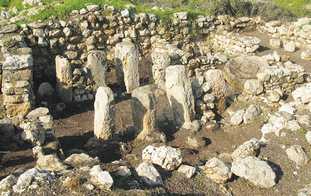Archeologists uncover finest example of Israelite-era homeBy OREN KESSLER
07/04/2011 05:35

Four-room structure at Tel Shikmona site near Haifa also boasts mosaics, artifacts testifying to the considerable wealth of its owners.
An archeological dig near Haifa recently uncovered a 3,000-year-old house that is the best-preserved structure yet discovered from the Israelite period.
The four-room structure also boasts mosaics and artifacts testifying to the considerable wealth of its owners.
The site at Tel Shikmona – in Shikmona Nature Reserve at Haifa’s southern edge – was partially excavated 40 years ago, but years of neglect left the area covered with garbage and earth.
“We had seen the structure in the old photographs, and were sorry that such a rarely preserved finding had disappeared due to neglect. We were not even sure that we would be able to find it again,” said excavation leaders Dr. Shay Bar and Dr. Michael Eisenberg in a statement.
“It was practically a miracle that we managed to locate and uncover it and that it is still so well preserved.”
Excavations in the 1970s revealed remains of human settlement from as early as the late Bronze Age (16th century BCE) to the Muslim conquest of the 7th century CE.
Researchers said the new finding presents a rare opportunity to study everyday life in the days of the Kingdom of Israel, and that ultimately they hope to include the structure in the public archeological park.
The excavation also revealed a personal seal showing an inscription in either Hebrew or Phoenician. Researchers hope that by deciphering the inscription they will be able to ascertain whether the settlement was Israelite or Phoenician.
Other findings in the area reveal extensive trade among regional neighbors, such as Cyprus and Lebanon, including vessels for transporting the purple mollusc-shell dye for which the Phoenicians were legendary.
Further excavation revealed remains of Byzantine structures from the 4th to 7th centuries CE containing mosaic floors, intact ceramic vessels, coins, ornaments, weapons and glassware. Deeper still, excavators found a 4th-century CE Persian-era oven and storage pitchers.
The overall impression is of an originally sparsely populated community growing more populous over time, until by the first century BCE it had become a prosperous, fortified city with extensive trade.
http://www.jpost.com/NationalNews/Article.aspx?id=227791